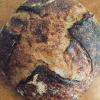September 12, 2018 - 8:09am

I did something dumb
So.
I wanted to give my starter a real nice refresh–I haven't been getting the structure in my dough that I am wanting and have read that rogue enzymatic activity could be the culprit so I figured I'd work at this variable.
I WANTED to do a refresh of 1:5:5 (20g starter | 100g water | 100g flour)
I do a blend of flour, and wasn't paying attention and added WAY too much of AP flour and had to add more water to keep it at 100% hydration.
Long story short is that I ended up with a 1:10:10 (20g starter | 200g water | 200g flour).
My question is–do you think given the amount of starter:water:flour I ended up feeding it, will be enough to get proper fermentation going, or did I just kill my starter?
Thanks!


A small amount of starter will inoculate a large feed.
I've made bread with 2% starter before.
In fact it'll probably do your starter good to build up a healthy yeast population. Keep it warm and give it another stir in a few hours.
Just to clarify-you are saying only to STIR it in a few hours, but I should wait until it looks like it is nice and bubbly to feed it again. (hoping for somewhere around 12 hours, but we'll see with this large of a ratio.)
Stir it because you're taking the yeasts to the food (or the food to the yeasts whichever way you look at it). And wait until it's active and bubbly before feeding again.
of head room or space to grow in its container. More than likely it will expand more than 5 times its volume. I would even go so far as to put a bowl under the jar. Mark the starting level and then in 4 hours. Stir. Mark every 2 hours after that. I would only stir if the starter is not rising. Once the yeast make enough gas to raise the starter, the bubbles will do the stirring. Then just watch to peak. A tall jar is easier to judge than a flat container.
A thin starter will not rise as much as a thicker consistency starter but they both can surprise with activity.
What is the temperature of the starter?
How did the big feed fair?
I use a 1:10:10 feeding ( or less water 8) to test newly formed starters when I think the yeast has bloomed into the new starter. The resulting starter is either a temporary dud (which means waiting another day developing the starter) or it is super charged ready to go into a loaf when it peaks.
Established starters can be fed up to 1:20:20 without problems but for a maintenance feeding, do let the bacteria numbers catch up before another large feeding to help the starter culture defend itself from possible invasion when a large amount of flour is introduced. I know, maybe too much information. What happens is that when feeding a large portion of flour, the pH shoots up, this signals the bacteria to produce like crazy to lower it again but they have their limits and meanwhile the yeast just go for the food while it lasts. When yeast start to stress, they put out more gas. As you know, this situation is what we manipulate to raise our bread loaves
With small feedings we stimulate yeast but not the bacteria when pH stays low enough. Too low starves the yeast. With very large feedings we seem to flavour yeast growth but this is not good long term maintenance. Bacterial growth is needed to fend off invasion from the first bacteria encountered when first starting up the starter as they dwell in the flour. They are reintroduced with each feeding and therefore it is important that the culture sample have enough bacteria to continue the process.
What we seem to find ideal to maintain our starters is a feeding somewhere between equal amounts of starter to anywhere up to five times the flour without diluting the acid in the starter too much. If the flour food dilutes the acid too much, then counter time or a warm spot is needed to let the bacteria and yeast get a start at building acid and population before the starter is returned to the fridge or pantry to slow it down between feeds. Counter time will vary greatly with inoculation size and type of flour and the amount of water in the starter.
Yeast populations will double* on the average of every 1.5 hours depending on temp and flour. So by the time of the first peak, it is loaded with yeast and gas content will be doubling fast as time goes by and esp. when the yeast detects food sources are declining.
* Double in this sense means 1 doubles to 2, 2 doubles to 4, 4 to 8, 8 to 16, at the end of the fifth doubling, 16 is 32 times the original amount of starter yeast.